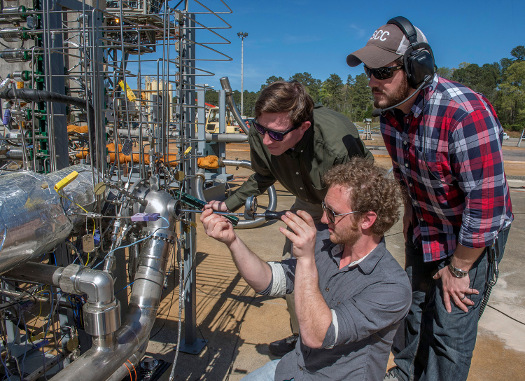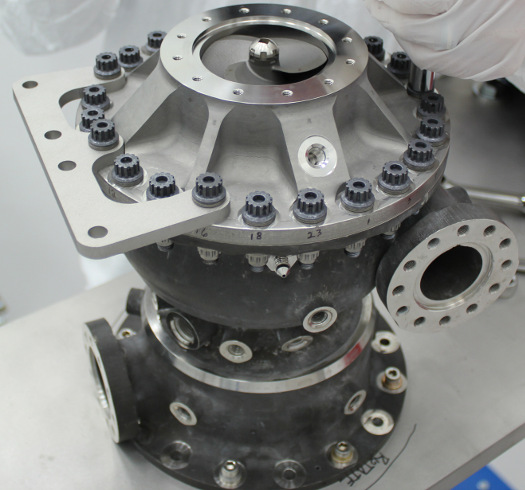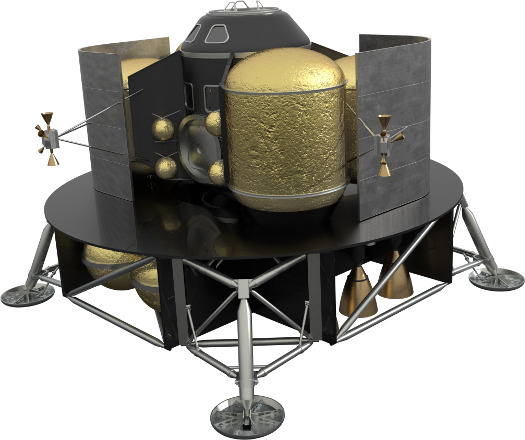 |
| May 17, 2016 | Volume 12 Issue 19 |
Designfax weekly eMagazine
Archives
Partners
Manufacturing Center
Product Spotlight
Modern Applications News
Metalworking Ideas For
Today's Job Shops
Tooling and Production
Strategies for large
metalworking plants
Toolbox:
NASA tests 3D-printed rocket engine turbopump with liquid methane

Engineers prepare a 3D-printed turbopump for a test at NASA's Marshall Space Flight Center. The turbopump was tested at full power, pumping 600 gal of liquid methane per minute, enough to power an engine capable of generating 22,500 lb of thrust. An engine with this technology is an ideal candidate for a Mars lander. [Credits: NASA/MSFC/Emmett Given]
By Tracy McMahan and Kimberly Newton, NASA Marshall Space Flight Center
NASA has tested a 3D-printed rocket engine turbopump with liquid methane -- an ideal propellant for engines needed to power many types of spacecraft for NASA's journey to Mars.
"This is one of the most complex rocket parts NASA has ever tested with liquid methane, a propellant that would work well for fueling Mars landers and other spacecraft," said Mary Beth Koelbl, the manager of the Propulsions Systems Department at NASA's Marshall Space Flight Center in Huntsville, AL. "Additive manufacturing, or 3D printing, made it possible to quickly design, build, and test two turbopumps with identical designs that worked well with both liquid methane and liquid hydrogen propellant."

This rocket engine fuel pump has hundreds of parts, including a turbine that can spin at 36,000 rpm. The turbopump was made with additive manufacturing and had 45 percent fewer parts than pumps made with traditional manufacturing. It completed testing under flight-like conditions at NASA's Marshall Space Flight Center in Huntsville, AL. [Credits: NASA/MSFC]
A turbopump is complex because it has turbines that spin fast to drive the pump, which supplies fuel to the engine. During the full power test, the turbines generated 600 hp, and the fuel pump got its "heartbeat" racing at more than 36,000 rpm, delivering 600 gal of semi-cryogenic liquid methane per minute -- enough to fuel an engine producing over 22,500 lb of thrust. Three other tests were completed at lower power levels.
Hydrogen turbopump component testing and testing with a liquid oxygen/liquid hydrogen breadboard engine were completed in 2015. These tests, along with manufacturing and testing of injectors and other rocket engine parts, are paving the way for advancements in 3D printing of complex rocket engines and more efficient production of future spacecraft, including methane-powered landers.
"Methane propulsion and additive manufacturing are key technologies for the future of exploration, including NASA's journey to Mars," said Graham Nelson, a Marshall propulsion engineer who helped with the testing. "We're excited to complete testing that advances both these technologies at the same time and improves the capabilities of future missions."

NASA planners are studying several concepts for Mars landers for human spaceflight missions. In this artist's concept, fuel tanks are filled with liquid methane and liquid oxygen, and the lander is fitted with engine nozzles. [Credits: NASA]
Liquid methane is cooled to -255 F (-159 C), whereas liquid hydrogen is cooled to -400 F (-240 C). The higher temperature of liquid methane means it boils off more slowly and thus is easier to store for longer periods, a benefit for Mars missions. Also, technologies exist today to make it possible to manufacture methane rocket fuel from carbon dioxide, which is plentiful in the Red Planet's atmosphere.
VIDEO: This video shows a test with a NASA 3D-printed turbopump. As the turbopump moves 600 gal of liquid methane per minute, frost forms on the outside because the fuel is super-cooled to -255 F. Methane burns out the flame pipe at the end of the test area. [Credits: NASA/MSFC]
"By demonstrating the same turbopump can work with different fuels, we've shown that a common design would work for either engines fueled by methane or hydrogen," said Marty Calvert, the Marshall engineer who designed the turbopump. "Because liquid methane is much more dense than hydrogen, it requires the turbopump to spin at a different speed to deliver the same amount of mass flow to the engine."
Testing ensures 3D-printed parts operate successfully under conditions similar to those in landers, ascent vehicles, and other space vehicles. Test data are available to American companies working to drive down the cost of using this new manufacturing process to build parts that meet aerospace standards. All data on materials characterization and performance are compiled in NASA's Materials and Processes Technical Information System, called MAPTIS, which is available to approved users.
"Additive manufacturing allowed us to build the turbopump with 45 percent fewer parts," said Nick Case, the Marshall propulsion engineer who led the testing. "This made it affordable to build two turbopumps, get them on the test stand quickly, and get results. Our next step will be to test the liquid methane turbopump with other 3D-printed engine components in a similar configuration to the liquid hydrogen tests completed last year."

Source: NASA
Published May 2016
Rate this article
View our terms of use and privacy policy
